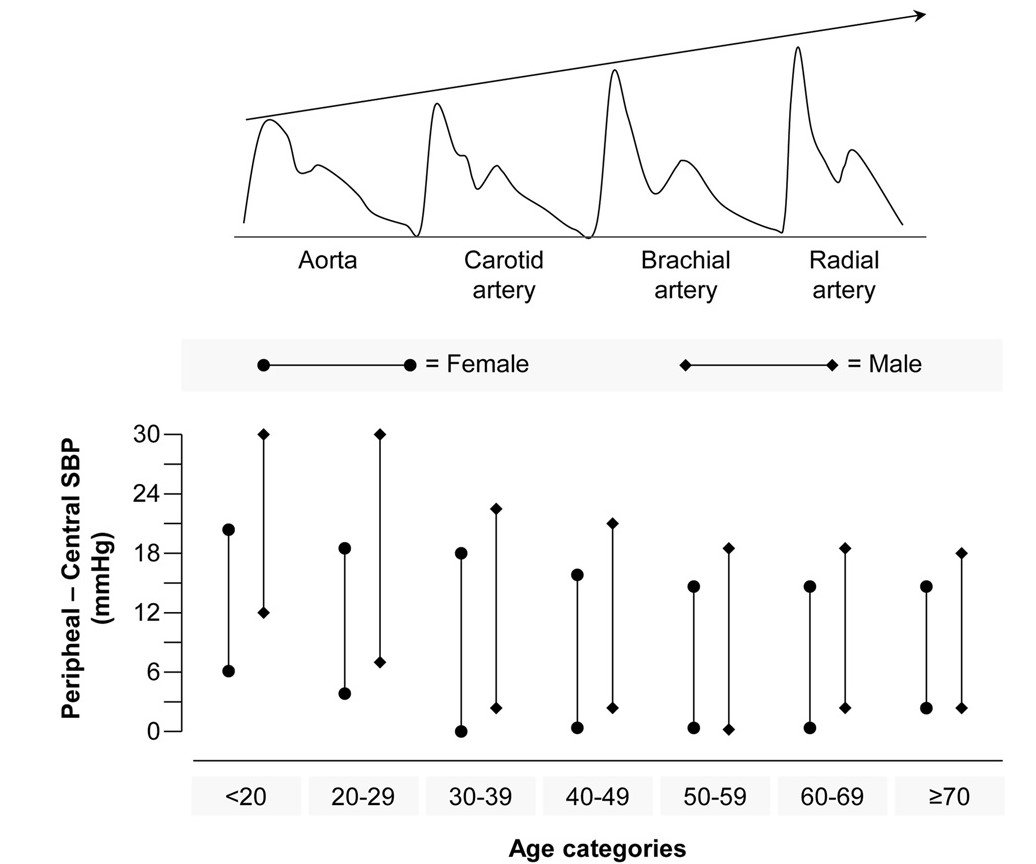Central Blood Pressure (CBP)
Aortic blood pressure
The central blood pressure (CBP) serves as a vital hemodynamic indicator, reflecting the pressure within the aorta. This pressure is affected by the amount of blood pumped by the heart (ejected stroke volume) and how the large arteries soften or reduce this pressure. It also depends on how the pressure waves, caused by the heart, move through the arteries and bounce back. When the heart pumps, a pressure wave travels through the arteries and returns as an echo from different points. So, at any point in the arteries, you can see the original wave moving forward and the echoed wave moving back.
In healthy arteries, which are flexible, the reflected (echoed) wave joins the original wave during the heart’s resting phase (diastole). This helps increase diastolic pressure, which is important for blood flow to the heart (coronary perfusion). But when the arteries are stiff, the pressure waves move faster, and the reflected wave hits the original wave during the heart’s active phase (systole), raising the systolic pressure instead. This increases the workload on the heart and makes it harder for the heart to relax and get enough blood (coronary filling).
One of the primary influencers of central blood pressure is arterial stiffness, which is subject to fluctuations based on both hemodynamic and non-hemodynamic factors. In comparison with conventional cuff brachial blood pressure, CBP is a better cardiovascular prognostic marker. It can be a good determinant or even preventive factor of the disease prognosis. For example, in individual’s adult with normal central blood pressure in the spurious hypertension phenomenon, which is seen in isolated systolic hypertension, the risk of organ damage can be predicted to be pretty low.
What is Central Blood Pressure and Aortic blood pressure?
Central blood pressure (CBP) refers to the pressure within the aorta, the body’s largest and most vital artery, responsible for transporting oxygen-rich blood directly from the heart to nourish all other organs and tissues. Clinical studies have shown that CBP, along with pulse pressure, is a stronger predictor of cardiovascular risk and hypertensive organ damage than brachial blood pressure.
Central Blood Pressure Measurement
The difference between brachial blood pressure (measured in the arm) and central blood pressure (measured in the aorta) arises due to pressure wave amplification as blood travels through the arteries.
In healthy individuals, the pressure in the aorta (central blood pressure) is typically lower than the brachial blood pressure due to physiological and structural differences between the central and peripheral arteries. The aorta, being a large and highly elastic artery, acts as a cushion, absorbing some of the energy from the heart’s pressure wave.
Using the correct methods and non-invasive tools is essential for accurately measuring and interpreting central blood pressure (CBP). For instance, CBP provides better insight into the development of cardiovascular disease than brachial pressure. Additionally, central pulse pressure has a stronger connection to blood vessel thickening, atherosclerosis, and cardiovascular events than brachial pulse pressure.
As a general reference, optimal brachial blood pressure falls within the range of 90/60mmHg to 120/80mmHg. Blood pressure is categorized as high if it reaches 140/90mmHg or above, and low if it falls below 90/60mmHg. However, it is advisable for central systolic blood pressure (SBPao) to be maintained below 140 mmHg and to be lower than brachial blood pressure.
Its calculation can be easily done using the simple Arteriograph measurement.



